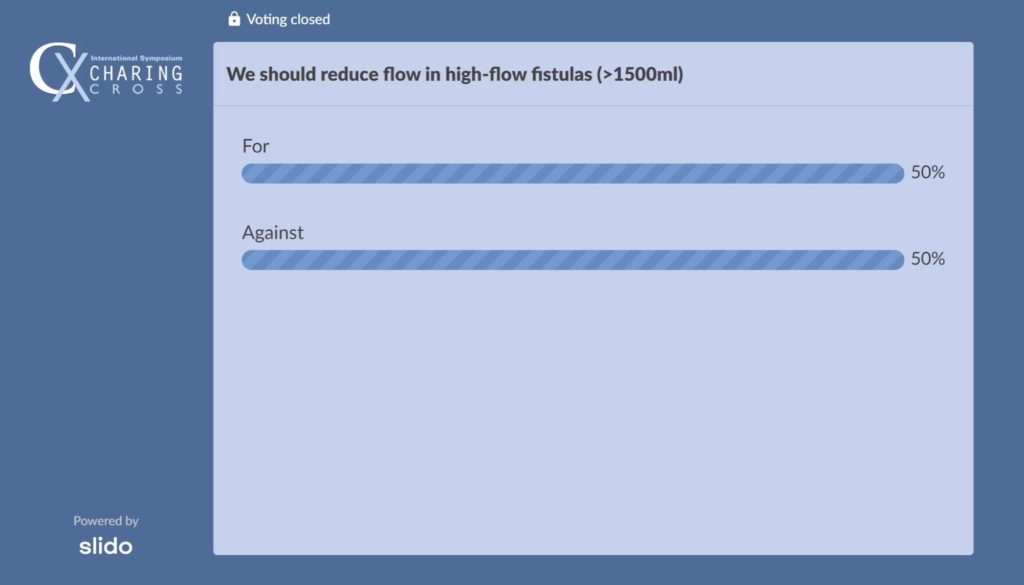
Consensus is split over the need for flow reduction in high-flow fistulas to avoid cardiac complications in dialysis patients, polling taken during the Charing Cross (CX) 2021 Digital Edition (19–22 April, online) has revealed. Attendees to the Vascular Access Controversies session at CX 2021 delivered a 50/50 vote when asked to consider the need to reduce high-flow fistulas (>1500ml) during the debate of the day.
All Vascular Access sessions are available to view on demand. Click here to register and access the recordings.
The audience was told that high-flow fistulas can lead to major cardiac consequences—with Paul Gibbs (Portsmouth, UK) pointing to evidence showing the prevalence of heart disease in renal patients. However, this was contested by Surendra Shenoy (St Louis, USA), who argued against the need for routine flow reduction in asymptomatic patients. Shenoy described the fistula as the “bystander” in these patients, adding: “Why shoot the fistula, which is serving them to stay alive?”
In a session that featured global insights into high flow in access controversies, Robert Shahverdyan (Hamburg, Germany) presented initial clinical experience using the Frame FR (Vascular Graft Solutions) external stent. Shahverdyan described the device as an external banding tool used to support the vein at the anastomosis. The device, he said, offers an additional, feasible and effective treatment for aneurysm and flow reduction. “It prevents redilation of the vein and further aneurysm formation, which also prevents recurrent high flow,” Shahverdyan commented.

Paclitaxel issue “closed” in vascular access—CX 2021 experts conclude
Earlier in the session, a Podium 1st from Andrew Holden (Auckland, New Zealand) delivered 24-month results from the IN.PACT AV drug-coated balloon trial (Medtronic). Over two years, the IN.PACT paclitaxel-coated balloon demonstrated a continued clinical benefit compared to percutaneous transluminal angioplasty (PTA) in the control group.

Holden stated “durable, long-term data suggests the use of this therapy as a standard of care for patients with end-stage renal disease who are at a high risk of repeat interventions”, adding that the target-lesion primary patency rates seen during the trial indicate a “highly-significant advantage” over standard balloon angioplasty, with no difference in all-cause mortality being observed.
Session moderator Nicholas Inston (Birmingham, UK) asked if the results “draw a line” under the paclitaxel mortality issue in renal patients. Holden replied: “I am very happy to say that just as with the femoropopliteal segment, which first reported mortality at two years, we can now say that the two-year data for the first time shows no mortality signals.”
Registrants can view this presentation on demand here.
Surveillance without intervention—Little more than supervised neglect?
Later in the session, David Kingsmore (Glasgow, UK) offered insights into maintenance of the long-term function of arteriovenous grafts (AVGs) in treating venous stenosis. The presentation prompted discussion about the role of surveillance in preserving vascular access. Kingsmore stated that “we absolutely, fundamentally need to reconsider what surveillance is—it is not about imaging, it is about surveillance programmes”. He went on to agree with Inston that “surveillance is little more than supervised neglect” without intervention, while co-moderator Domenico Valenti (London, UK) added to the debate by stating “we should learn a lesson from vascular and peripheral surgery on this, where you usually survey the distal bypass for a year or several months”.
Registrants can view this session on demand here.
In the day’s final session, consultant nephrologist Peter Thomson (Glasgow, UK) discussed optimising arteriovenous access care by considering the individual patient’s needs. He emphasised that this should be done prior to making the decision on whether to use a central venous catheter (CVC), arteriovenous fistula (AVF), or any other potential access strategy, referencing recent articles in the Journal of Vascular Access and BMC Nephrology that focus on quality-of-life impacts over other outcome measures.
Registrants can view this presentation on demand here.













